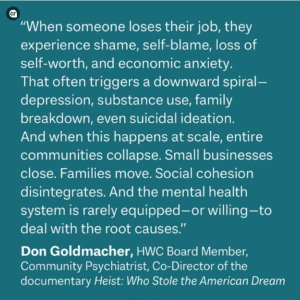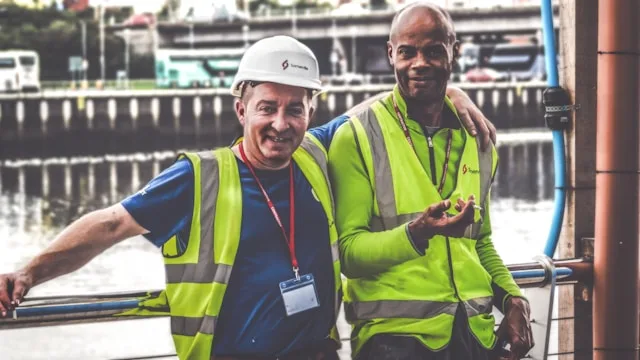
By Zack Kaldveer via LinkedIn Campaña Trabajo Saludable
What happens when millions of Americans lose stable, good-paying jobs—not because of performance, but because of corporate outsourcing, automation, or deregulation?
According to decades of research, including M. Harvey Brenner’s landmark book Mental Illness and the Economy, economic instability and job loss are directly tied to increased rates of mental illness. His analysis of over a century of data revealed that economic downturns are a primary driver of admissions to state mental hospitals.
More recently, The Disposable American (https://lnkd.in/gD6PVKjk) by Louis Uchitelle and The Far-Reaching Impact of Job Loss and Unemployment (https://lnkd.in/gvXg-q3N) by Jennie Brand echoed this reality: layoffs don’t just harm individual workers—they unravel families, communities, and long-term health outcomes.
Dr. Don Goldmacher, Healthy Work Campaign (HWC) Board Member, Community Psychiatrist, Co-Director of the documentary Heist: Who Stole the American Dream, and key contributor to this post, breaks it down:
“When someone loses their job, they experience shame, self-blame, loss of self-worth, and economic anxiety. That often triggers a downward spiral—depression, substance use, family breakdown, even suicidal ideation. And when this happens at scale, entire communities collapse. Small businesses close. Families move. Social cohesion disintegrates. And the mental health system is rarely equipped—or willing—to deal with the root causes.”
So, why is this still ignored? Why do our systems continue to treat job loss as an individual failure rather than a public health emergency?
This is why HWC exists: to expose the psychosocial impacts of job loss, promote structural solutions, and challenge the narratives that blame workers for crises they didn’t create.
What can employers do instead of turning layoffs into trauma? Our proposed solutions (https://lnkd.in/gsPNmNbA) include:
· Reduce hours, not people – Explore furloughs or shorter workweeks as alternatives to permanent layoffs.
· Be transparent, early – Communicate openly with workers, unions, and local communities before decisions are made.
· Invest in your people – Offer job retraining, upskilling, and cross-training to help workers adapt and grow.
· Support the search – Give laid-off workers paid time to job hunt and prepare for their next step.
· Prioritize mental health – Provide counseling and support services to those impacted.
· Don’t double the burden – After layoffs, make sure remaining staff aren’t silently doing 2–3 jobs.
It’s time to center dignity, stability, and health in economic and labor policy.
From Neglect to Crisis — How Trump’s Agenda Deepens Worker Exploitation and Public Harm
As we detailed in our recent op-ed “Sick and Unsafe”, Trump’s policies are supercharging this public health emergency—fueling mass layoffs, dismantling worker protections, and dehumanizing federal employees in ways we’ve never seen at this scale.
This is not just bad policy. It’s a deliberate strategy: stripping away rights, targeting public servants, and creating economic “deserts” where despair thrives. The impact on the health of working people has been all too real: Self-blame, loss of self-worth, economic stress, substance use, family breakdown, depression and even suicidal ideation.
But here’s the truth: the working class was abandoned long before Trump. For decades, both major parties have failed to protect good jobs, allowed corporate outsourcing and deregulation to erode local economies, and turned a blind eye to the psychosocial toll this takes.
The US never fully embraced a serious industrial policy that invests in and sustains domestic manufacturing. Instead, we doubled down on “free trade” agreements that hollowed out industries and shipped millions of blue-collar jobs overseas, while failing to value the long-term economic and social benefits of making things here at home.
Decades of neglecting strategic investment in key sectors—while other nations protected and nurtured theirs—left our workforce vulnerable and our economic base gutted. This, combined with a systematic attack on unions and the already weak social safety net—ignited by Reagan and driven by the right wing ever since—left tens of millions of workers and their families and communities on the junk heap to wither away, leaving them psychologically vulnerable to emotional manipulation by a right wing demagogue candidate posing as an “outsider” who would fix a broken system.
Many working people believed him—because the anger and betrayal they felt were real. But now, the reality is undeniable: far from fixing the system, Trump has deepened the wounds, handed more power to corporate elites, and left the same communities even more vulnerable.
We must not only fight against the symptoms of economic injustice, but against the policies and narratives that create them too. If we want a healthy, dignified future for working people, we have to start by telling the truth: job loss is not just an economic inconvenience. It’s a public health crisis resulting from policies that prioritize shifting capital and resources from working people to wealthy people and corporations. It’s time to stop electing leaders who make it worse and start putting worker health first.






